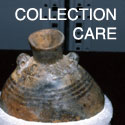Who and What is a Registrar?
A colleague once described a registrar as a “travel agent for the art” and this description appeals to me. A registrar maintains records of accession, condition, and location of objects in museum collection, and oversees movement, packing, and shipping of objects to conform to insurance regulations. Observes unpacking of objects acquired by museum through gift, purchase, or loan to determine that damage or deterioration to objects has not occurred. Registers and assigns accession and catalog numbers to all objects in collection, according to established registration system. Composes concise description of objects, and records descriptions on file card and electronic database. Oversees handling, packing, movement, and inspection of all objects entering or leaving establishment, including traveling exhibits, and confers with other personnel to develop and initiate most practical methods of packing and shipping fragile or valuable objects. Maintains records of storage, exhibit, and loan locations of all objects in collection for use of establishment personnel, insurance representatives, and other persons utilizing facilities. Prepares acquisition reports for review of curatorial and administrative staff. Periodically reviews and evaluates registration and catalog system to maintain applicability, consistency, and operation. Recommends changes in record keeping procedures to achieve maximum accessibility to and efficient retrieval of collection objects. Arranges for insurance of objects on loan or special exhibition, or recommends insurance coverage on parts of or entire collection.



